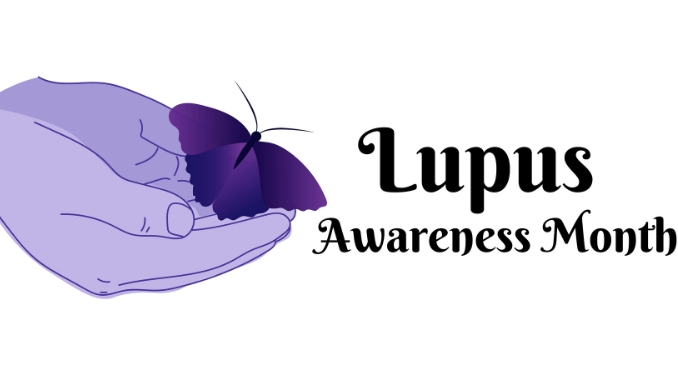Celebrating Strength and Resilience: Embrace Lupus Awareness Month

Welcome to Lupus Awareness Month, a time to celebrate the strength and resilience of individuals living with lupus. This annual observance aims to raise awareness about this complex and often misunderstood autoimmune disease.
Furthermore, this post warmly explores the hurdles encountered by individuals living with lupus Systemic Lupus Erythematosus (SLE) and underscores the significance of disseminating knowledge and fostering understanding. Join us on this journey as we shed light on the impact of lupus, a chronic autoimmune disease, on individuals and their families and provide valuable resources for support and education.
Lupus Awareness Month
May is Lupus Awareness Month, and World Lupus Day is celebrated every 10th of May.
Lupus Awareness Month is an annual observance to raise awareness of lupus, a global health condition impacting millions of individuals worldwide, characterized by an autoimmune response. This aims to educate the public about lupus, its complex symptoms, and the challenges of living with this misunderstood disease.
Lupus is a condition characterized by an autoimmune response, where the immune system erroneously targets and harms normal tissues and organs. This can lead to many symptoms and health complications, including joint pain, skin rashes, fatigue, and more. Lupus can affect almost any part of the body, making it a particularly challenging condition to diagnose and manage.
Moreover, this condition is symbolized by the graceful purple butterfly, much like the regal purple emperor and the delicate purple hairstreak butterflies in nature. One of its distinguishing features is a distinctive rash that often resembles the elegant wings of a butterfly. This rash, commonly known as a “butterfly rash” or malar rash, typically spreads across the cheeks and the bridge of the nose, mirroring the symmetrical pattern seen in a butterfly's wings.
In essence, this analogy of lupus as a purple butterfly serves as a poignant representation of the condition's complex and multifaceted nature, where the outer beauty of the butterfly's wings belies the underlying intricacies and challenges posed by the disease's impact on the body's immune system and genetic stability.
Importance of Raising Lupus Awareness Month
1. Early Diagnosis and Detection
Many people with lupus experience a delay in getting an accurate diagnosis because its symptoms can mimic those of other illnesses. Early lupus diagnosis allows for timely medical intervention and management, which can significantly improve the prognosis.
2. Improved Understanding
Greater awareness fosters a better understanding of lupus among the general public, healthcare professionals, and policymakers. This understanding can lead to more research funding, improved healthcare policies, and better support systems for those with lupus.
3. Reducing Stigma
People with lupus often face misconceptions and judgment from others due to their visible and invisible symptoms. Increased awareness can dispel these misconceptions and also create a more supportive and empathetic society.
4. Support for Patients
Raising awareness also provides a platform for people with lupus to connect and share their experiences. Support groups and communities, such as a lupus community and Lupus Foundation of America, can form, offering emotional support, advice, and resources to individuals and their families coping with lupus's challenges.
5. Advance Lupus Research
Increased public awareness can lead to more funding for lupus. This funding can facilitate lupus drug development, improved diagnostic tools, and a better understanding of the underlying causes of the disease. Certainly, this can lead to more effective therapies and, potentially, a cure.
6. Empowering Patients
When people better understand their condition, its triggers, and how to manage it, they can take more active roles in their healthcare, leading to better health outcomes.
7. Symptom Management
Lupus awareness can educate patients about managing their symptoms and flares. Understanding their condition allows individuals to make informed lifestyle choices, such as adopting healthier diets, reducing stress, and avoiding triggers exacerbating their symptoms.
8. Reducing Health Disparities
Lupus disproportionately affects certain demographic groups, particularly women of color. Raising awareness can draw attention to these health disparities and drive efforts to improve healthcare access and equity for all individuals with lupus.
Lupus Awareness Month Events and Activities
1. Lupus Walks and Runs
Organize community walks or runs to raise funds and awareness for lupus research and support. Participants can register and create teams to fundraise, and the event can include educational booths and information about lupus.
2. Lupus Information Seminars
Host seminars and workshops to educate the public, patients, and their families about lupus, its symptoms, treatments, and coping strategies. Invite healthcare professionals and patients to share their experiences.
3. Social Media Campaigns
Launch a social media campaign using a specific hashtag, encouraging people to share their lupus stories, facts, and pictures wearing purple to spread awareness.
4. Purple Day
Encourage individuals, schools, and workplaces to wear purple and share lupus information to raise awareness.
5. Lupus Art and Craft Exhibitions
Organize art and craft exhibitions featuring work by patients or artwork related to lupus themes. This can be a creative way to educate and inspire.
6. Raise Funds
Host fundraising events such as charity dinners, auctions, or bake sales to collect funds for lupus research and patient support organizations.
7. Support Group Meetings
Arrange special support group meetings during Lupus Awareness Month to provide a safe space for lupus patients and their families to connect, learn, and share experiences.
8. Online Webinars
Conduct online webinars featuring rheumatology, immunology, and lupus research experts to discuss the latest developments in lupus treatment and management.
9. Educational Workshops in Schools
Collaborate with local schools to organize lupus awareness workshops for students. It's essential to educate the younger generation about lupus.
10. Lupus Awareness Merchandise
Create lupus awareness merchandise such as t-shirts, wristbands, and pins, and sell them with the proceeds for research and support.
11. Patient Storytelling
Share personal stories of lupus patients through various media channels to humanize the disease and show its real impact on people's lives.
12. Public Service Announcements (PSAs)
Partner with local media outlets to air lupus-related PSAs to reach a broader audience.
13. Health Fairs
Participate in or organize health fairs where lupus information can be disseminated, and attendees can receive educational materials and free screenings.
14. Letters to Legislators
Encourage people to write letters to their legislators, advocating for increased funding for lupus research and better healthcare access for lupus patients.
15. Collaborate with Lupus Organizations
Partner with established lupus organizations like the Lupus Foundation of America to leverage their resources and expertise.
Red Flags and Common Lupus Symptoms
Lupus' different symptoms are primarily due to how the immune system becomes dysregulated and attacks the body's tissues. Here are some key reasons why lupus manifests with different symptoms:
1. Extreme Fatigue
The most common constitutional symptom associated with lupus. This can be due to active SLE, medications, lifestyle habits, or concomitant fibromyalgia or affective disorders. People with lupus often feel exhausted even after getting enough rest or sleep.
2. Fever
This is another common yet nonspecific symptom of SLE, which may also result from many causes, the most common of which include active lupus, infection, and drug fever. Careful history-taking may help to differentiate these.
3. Arthralgias (Joint Pain & Swelling) and Myalgias (Muscle Aches & Pain)
Arthralgias and myalgias are two distinct but often interconnected symptoms commonly experienced by individuals with lupus.
Myalgias, characterized by achy or tender muscles, can result from inflammation and immune system activity in lupus, potentially leading to myositis, an inflammation of muscle tissue. These myalgias can be unsteady during lupus flares and may affect muscles throughout the body. On the other hand, lupus can also induce joint inflammation, causing pain, swelling, and stiffness, primarily in the fingers, wrists, knees, and ankles.
Arthralgias, however, manifest as joint discomfort without visible inflammation and are frequently reported by lupus patients. This joint pain can affect various joints, resembling arthritis symptoms but not always involving noticeable joint swelling.
4. Headache
Headaches in individuals with lupus can manifest with varying degrees of severity and frequency, from mild to severe, and may occur seldom or persistently. Some individuals may also experience migraines, while others contend with more persistent headache patterns.
5. Weight Loss/Weight Changes
Lupus can cause weight gain in some people, but it can also cause weight loss. The most common cause of weight gain in people with lupus is corticosteroids, a type of medication used to treat the disease.
Corticosteroids can increase appetite and make it difficult to lose weight. Weight gain may also be due to corticosteroid treatment (helps reduce inflammation) or active diseases such as nephrotic syndrome anasarca (kidney damage). These symptoms can imitate other autoimmune diseases, infectious diseases, endocrine abnormalities, chronic fatigue, and fibromyalgia.
6. Skin Rash
A characteristic butterfly-shaped rash across the cheeks and bridge of the nose is a classic sign of lupus. However, rashes can also appear on other parts of the body and may be photosensitive, meaning they worsen with exposure to sunlight. Many individuals with lupus are sensitive to sunlight or other ultraviolet (UV) light sources. Sun exposure can trigger or worsen symptoms, leading to rashes, joint pain, fatigue, and even organ inflammation.
7. Raynaud's Disease
People with lupus may experience Raynaud's phenomenon, characterized by cold fingers and toes, color changes in response to temperature changes or stress, and numbness or tingling sensation in the affected areas.
The exact means by which lupus causes Raynaud's is not fully understood. However, it is believed that the immune system dysfunction in lupus leads to the narrowing of blood vessels, known as vasoconstriction. This narrowing in the blood vessels reduces blood flow to the affected areas, leading to the characteristic color changes and numbness experienced in Raynaud's phenomenon.
8. Mouth Sores (Ulcers)
The sores can appear on the gums, cheeks, and lips but usually emerge on the mouth's roof. They may not feel pain in this area, or you may have soreness or dry mouth.
Mouth sores in lupus, also known as lupus-visible oral lesions, are a common manifestation of this autoimmune disease. These sores often appear as painful ulcers or lesions on the mucous membranes inside the mouth, making them visible signs of lupus activity. Mouth sores can be a significant source of discomfort for individuals living with the condition.
9. Eye Problem
You may get eye inflammation, dry eyes, and eyelid rashes.
Lupus can cause various eye issues, including dry eyes, retinal damage, and inflammation of the eye's blood vessels (vasculitis). These complications can lead to vision problems and eye discomfort.
10. Psychosis
Lupus can impact the central nervous system, causing neuropsychiatric symptoms such as psychosis, cognitive dysfunction, and mood disturbances. This is referred to as neuropsychiatric lupus.
The Life Expectancy of a Person with Lupus
The life expectancy of a person with lupus can vary widely due to disease severity, management, and overall health. Despite lupus's challenges, many individuals can expect a normal or near-normal lifespan with proper medical care and treatment.
Advances in treatment have improved outcomes over time, but a personalized treatment plan in collaboration with healthcare professionals, including medication for inflammation control, symptom management, and immune system regulation, is crucial. Lifestyle adjustments like a nutritious diet, regular exercise, and sun protection are also beneficial.
Nonetheless, lupus can be unpredictable, with varying degrees of severity and, in rare cases, life-threatening complications, underscoring the importance of early diagnosis, regular check-ups, and ongoing management for long-term well-being.
While the life expectancy of a person with lupus can vary depending on various factors, such as the severity of their condition and adherence to a lupus diet, it is generally improved with proper management and a healthy lifestyle.
Lupus and Genetic Risk Factors
While no single gene or specific group of genes has been definitively established as the cause of lupus, certain gene variations have been associated with the condition. Lupus does, however, seem to exhibit a familial pattern.
For instance, if one identical twin develops lupus, the likelihood of the other twin, who shares the same genetic makeup, also developing the condition is higher. Research suggests that individuals with a family history of lupus may face an elevated risk of developing the disease.
Diseases that Go Along with Lupus
- Celiac Disease: This is triggered by gluten consumption, causing wear to the small intestine and leading to digestive and nutritional problems.
- Myasthenia Gravis: Myasthenia gravis is characterized by muscle weakness and fatigue because of an autoimmune attack on the neuromuscular junction, impairing communication between nerves and muscles.
- Rheumatoid Arthritis: This autoimmune disease primarily affects the joints, causing inflammation, pain, and joint tissue damage.
- Autoimmune Thyroid Disease: This condition involves the immune system attacking the thyroid gland, leading to problems with hormone production and regulation, which can affect metabolism and energy levels.
- Polymyositis: Polymyositis is an autoimmune muscle disease causing muscle inflammation and weakness, particularly in the proximal muscles (those closest to the body's trunk).
- Sjögren’s Syndrome: This syndrome primarily targets the salivary and tear glands, resulting in dry mouth and eyes.
- Dermatomyositis: Like polymyositis, dermatomyositis involves muscle weakness and inflammation but also includes skin rashes and other skin-related symptoms.
- Scleroderma: Scleroderma is characterized by the hardening and tightening of the skin and connective tissues due to excessive collagen production. It can affect various organs and body systems.
- Antiphospholipid Syndrome: This autoimmune disorder is marked by the production of antibodies that increase the risk of abnormal blood clot formation, potentially leading to serious complications like thrombosis and also pregnancy complications.
The Impact of Lupus on Individuals and Their Families
- Physical Health
- Emotional Well-being
- Social Life
- Daily Life
- Financial Burden and Economic Impact
- Impact on Family Dynamics
- Educational and Career Challenges
- Planning for the Future
- Impact on Children
- Access to Healthcare providers
Lupus is Considered a Disability
Lupus can be deemed a disability under the Social Security Administration's (SSA) definition of disability.
If your lupus symptoms are severe enough to prevent you from working, you may be qualified for disability benefits from the SSA. To qualify for these benefits, you must meet specific criteria and have medical evidence showing that your ailment is severe enough to prevent you from working. You must have a medical condition listed in the SSA's Blue Book of impairments. Lupus is listed in the Blue Book under Section 14.02 – Systemic Lupus Erythematosus.
Social Security will consider several factors when evaluating your claim for disability benefits, including the severity of your symptoms, the length of time you have been sick, and your age and education. If you are approved for disability benefits, you will receive a monthly payment.
It would also help if you talked to your physician about applying for disability benefits to help you gather the necessary medical evidence supporting your claim or contact the SSA for more information about the disability benefits process.
Conclusion
Lupus is challenging, but global scientific efforts strive to understand and treat it. With the dedication of “lupus warriors” and researchers, we aim to conquer this disease and improve lives.
Moreover, our mission is clear: support those with lupus, make it visible, and empower them. We foster a compassionate community where every voice is valued, struggles are understood, and triumphs are celebrated. Together, we create hope for a brighter future through knowledge, dedication, and action.
Rick Kaselj MS, is a leading kinesiologist and injury specialist as well as co-creator of the best-selling Unlock Your Hip Flexors program. Rick creates exercise programs that help people heal injuries and eliminate pain, so they can go back to living a full, active, healthy life.















